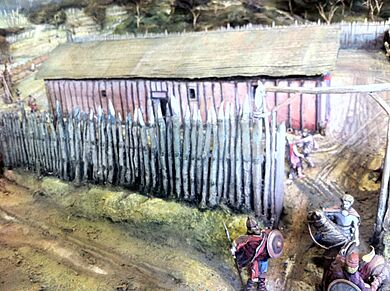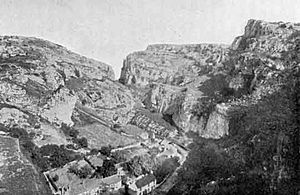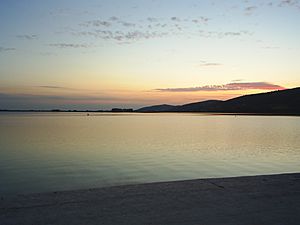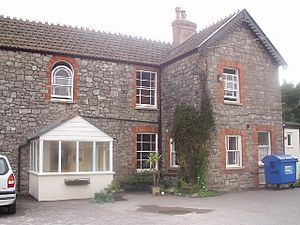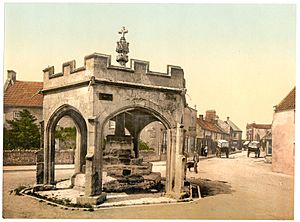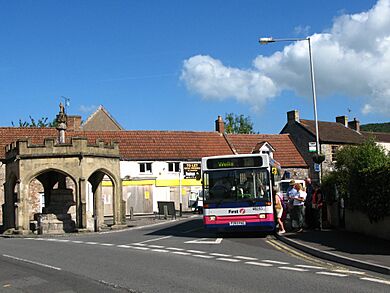Cheddar, Somerset facts for kids
Quick facts for kids Cheddar |
|
|---|---|
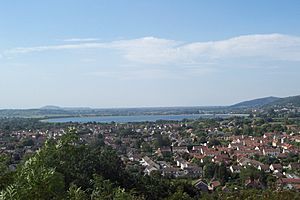 Cheddar village, looking due west from the tower at Jacob's Ladder |
|
| Population | 5,755 (2011) |
| OS grid reference | ST458535 |
| Unitary authority |
|
| Ceremonial county | |
| Region | |
| Country | England |
| Sovereign state | United Kingdom |
| Post town | CHEDDAR |
| Postcode district | BS27 |
| Dialling code | 01934 |
| Police | Avon and Somerset |
| Fire | Devon and Somerset |
| Ambulance | South Western |
| EU Parliament | South West England |
| UK Parliament |
|
Cheddar is a large village in Somerset, England. It sits at the southern edge of the Mendip Hills. It is about 9 kilometers (5.6 miles) north-west of Wells. The village is also 18 kilometers (11 miles) south-west of Bristol. In 2011, about 5,755 people lived here. The area includes smaller places called Nyland and Bradley Cross.
Cheddar Gorge, found just north of the village, is the biggest gorge in the United Kingdom. It has many show caves, like Gough's Cave. People have lived in the gorge since ancient times, even during the Saxon period. The village is famous for giving its name to Cheddar cheese. It was also known for growing strawberries. The strawberries used to travel on the Cheddar Valley railway, which is now a cycle path. Today, Cheddar is a popular place for tourists.
Contents
History of Cheddar
The name Cheddar comes from an old English word, ceodor. This word means "deep dark cavity" or "pouch".
People have lived in Cheddar since the Neolithic period (New Stone Age). In 1903, the oldest complete human skeleton in Britain was found in Cheddar Gorge. This skeleton, called Cheddar Man, is about 9,000 years old. Even older remains, from 12,000 to 13,000 years ago, have also been found. There is also proof of a Bronze Age farm system. Remains of a Roman villa have been found near the church.
Cheddar was an important place during the Roman and Saxon times. A royal palace stood in Cheddar during the Saxon period. Kings used it three times in the 900s for important meetings called the Witenagemot. The palace ruins were dug up in the 1960s. They are now on the grounds of the Kings of Wessex Academy. Roman remains were also found there. In the Domesday Book of 1086, Cheddar was called Ceder. This name meant "Shear Water."
By 1130 AD, Cheddar Gorge was known as one of the "Four wonders of England." For a long time, Cheddar made its money from farming and making cheese. Cheese making was famous here as early as 1170 AD.
In the 17th and 18th centuries, many watermills operated on the River Yeo. These mills ground corn and made paper. At one point, there were 13 mills. By 1915, only three were left. In the Victorian era, Cheddar also became a center for making clothes. The last mill, which was a shirt factory, closed in the early 1950s.
In 1789, William Wilberforce visited Cheddar and saw how poor the local people were. He inspired Hannah More to help improve life for the miners and farm workers in the Mendip Hills.
Tourism in the Cheddar gorge and caves started when the Cheddar Valley Railway opened in 1869. Cheddar has faced floods in the past. In 1968, a flood washed large rocks down the gorge and damaged buildings.
Cheddar's Location and Landscape
The area around Cheddar has different types of rock. These include limestone and sandstone. Over time, the weather has created thin, chalky soils.
The Famous Gorge and Caves
Cheddar Gorge, at the edge of the village, is the largest gorge in the United Kingdom. It is home to the Cheddar Caves. This is where Cheddar Man was found in 1903. The caves were formed by an underground river. They have amazing stalactites and stalagmites.
Gough's Cave was found in 1903. It goes about 400 meters (437 yards) into the rock. It has many large rock rooms and formations. Cox's Cave, found in 1837, is smaller but has very detailed formations. Another cave has a fun walk for children called the "Crystal Quest."
Cheddar Gorge and its caves are a big tourist spot. About 500,000 people visit each year. In 2005, a poll named Cheddar Gorge the second greatest natural wonder in Britain.
Special Nature Areas
There are several important nature areas around Cheddar called Sites of Special Scientific Interest (SSSI). These places protect special plants, animals, and geological features.
Cheddar Reservoir is a large, round man-made lake. It was built in the 1930s to hold water. The water comes from the Cheddar Yeo river, which starts in Gough's Cave. This reservoir is an SSSI because many waterfowl (birds that live on water) spend the winter there.
Cheddar Wood is another SSSI. It is what remains of old forests from the 10th and 13th centuries. This wood has many different habitats. It is home to rare plants like starved wood-sedge and purple gromwell. Many types of butterflies also live here, such as the silver-washed fritillary.
The largest SSSI is called Cheddar Complex. It covers a huge area of the gorge, caves, and surrounding land. It is important for both its wildlife and its geology. Parts of it are owned by the National Trust.
Quarries in the Area
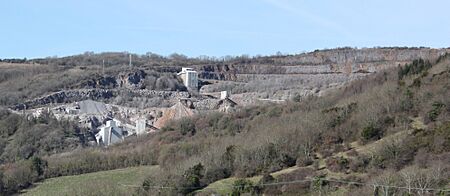
Near the village, there are active quarries called Batts Combe quarry and Callow Rock quarry. Here, limestone is still dug out of the ground. Batts Combe quarry has been working since the early 1900s. It produces thousands of tonnes of limestone every day.
The Chelmscombe Quarry stopped digging limestone in the 1950s. It was then used for testing things like power line towers. In the 1970s and 1980s, it was also used to test how well containers of radioactive material could handle crashes.
Cheddar's Weather
Cheddar has a mild climate, which means it's not too hot or too cold. It is generally wetter than other parts of the UK. The average temperature is about 10°C (50°F). Summers are warmest, with temperatures around 21°C (70°F). Winters are cooler, with temperatures around 1°C or 2°C (34°F or 36°F). The sea nearby helps keep temperatures steady. Most rain comes from storms over the Atlantic Ocean. The average rainfall is about 700 millimeters (27.5 inches) per year. It usually snows for 8 to 15 days each year.
 |
Shipham | Mendip Hills | Mendip Hills Cheddar Gorge |
 |
| Axbridge | Mendip Hills Priddy |
|||
| Somerset Levels | Somerset Levels Wedmore |
Wells |
People of Cheddar
In 2011, Cheddar had a population of 5,093 people. The average age was 43 years old. Most people lived in 2,209 homes. In the 2001 census, almost all households (2,183) said they were white.
2021 Census Information
The most recent census in 2021 showed that Cheddar had 6,263 people. About 51.1% were female and 48.9% were male. Over 6,101 people (97.3%) said they were white. About 1% (61 people) were Asian, 0.3% (17 people) were Black, and 1.3% (79 people) were of mixed background. Most people (94.1% or 5,900) were born in the United Kingdom. About 2.5% (156 people) were born in the European Union.
What Cheddar Makes and Does
The village gave its name to Cheddar cheese. This is the most popular type of cheese in the United Kingdom. Even though it's made all over the world now, only one producer still makes it in the village.
Since the 1880s, Cheddar has also been known for its strawberries. They are grown on the sunny lower slopes of the Mendip Hills. The old railway line that carried strawberries to market was even called The Strawberry Line. This railway opened in 1869. It used to connect Yatton to Wells. The line closed in 1964 and is now part of the Cheddar Valley Railway Nature Reserve.
Cheddar Ales is a small brewery in the village. It makes beer for local pubs. Tourism is a big part of Cheddar's economy. It is thought that tourism provides jobs for as many as 1,000 people in the village. Cheddar also has a youth hostel and places for camping.
Community and Fun in Cheddar
Cheddar has many active groups, like the Cheddar Vale Lions Club and Mendip Rotary. These clubs raise money for local projects. They also hold fun events every year. These include fireworks displays, duck races in the Gorge, and dragon boat races on the reservoir.
Many famous people have lived or were born in Cheddar. Jack Bessant, the bass guitarist from the band Reef, grew up on a strawberry farm here. Matt Goss and Luke Goss from the band Bros lived in Cheddar as children. Trina Gulliver, a ten-time World Darts Champion, used to live here. The comedian Richard Herring also grew up in Cheddar. His show, The Headmaster's Son, was about his time at The Kings of Wessex School.
Important Places in Cheddar
The market cross in Bath Street is from the 1400s. It was rebuilt in 1834. It has a central stone pillar and a hexagonal shelter. The cross is a very old and important monument.
In 2000, the cross was badly damaged in a car accident. It was rebuilt by 2002. However, in 2012, a taxi crashed into it again, causing more damage. Repair work was finished in November 2012. Wooden-covered steel posts were added to protect it from future crashes.
Hannah More, who helped many people, started a school in the village in the late 1700s. This school was for the children of miners. Her first school was in a house from the 1600s. This building is now called "Hannah More's Cottage" and is used as a meeting place for the community.
Getting Around Cheddar
The village is on the A371 road. This road goes from Wincanton to Weston-super-Mare. Cheddar is also about 5 kilometers (3 miles) from the M5 motorway.
Cheddar used to have a railway line called the Cheddar Valley line. It opened in 1869 and closed in 1963. It was known as The Strawberry Line because it carried so many local strawberries. Parts of this old railway are now a walking and cycling path called the Strawberry Line Trail.
The main bus service is the 126. It runs every hour between Weston-super-Mare and Wells. Other bus routes connect Cheddar to nearby towns and colleges.
Schools in Cheddar
The first school in Cheddar was started by Hannah More in the 1700s. Today, Cheddar has three schools that are part of the Cheddar Valley Group of Schools.
Cheddar First School teaches children aged 4 to 9. Fairlands Middle School has about 510 students aged 9 to 13. Children from Cheddar First School often move up to Fairlands. The Kings of Wessex Academy is a big school for students aged 13 to 18. It has about 1,176 students. Kings is a faith school linked to the Church of England. It has special facilities for technology and sports. The school also runs a sports center and swimming pool called Kings Fitness & Leisure. Students and local people can use these facilities.
Churches in Cheddar
The Church of St Andrew was built in the 1300s. It was repaired in 1873. The church has some beautiful stained glass from the 1400s. The tower is 30 meters (100 feet) tall. It holds a bell made in 1759. The churchyard is where the hymn writer William Chatterton Dix is buried.
Cheddar also has churches for Roman Catholic, Methodist, and Baptist faiths. The Baptist chapel was built in 1831.
Sports in Cheddar
Kings Fitness & Leisure, located at the Kings of Wessex School, is a great place for sports. It has a 20-meter swimming pool, courts for racket sports, a sports hall, dance studios, and a gym. In 2010, a skatepark was built in the village.
Cheddar A.F.C., the local football club, was started in 1892. They are nicknamed "The Cheesemen." Cheddar Cricket Club was formed in the late 1800s. They play at Sharpham Road Playing Fields. Cheddar Rugby Club was formed in 1836 and holds an annual tournament. Cheddar Lawn Tennis Club started in 1924.
The village is also on the routes of two long walking paths: the West Mendip Way and Samaritans Way South West.
Images for kids
See also
 In Spanish: Cheddar para niños
In Spanish: Cheddar para niños



